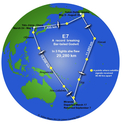The ocean has a complex circulation system, moving water, heat, salt1 and nutrients2 around the world. Surface currents in the top 400 m are driven mainly by wind. Deeper currents are driven by changes in water density. Both types of currents work with the atmosphere3 to help shape the Earth’s climate4.
Circling currents
There is a huge surface current circling around each of the main ocean basins5 (North Atlantic, South Atlantic, North Pacific, South Pacific and Indian Oceans). Different parts of Earth have winds that tend to blow in the same direction most of the time, called prevailing winds. These prevailing winds, combined with the expansion of warm water, cause the water to pile up into shallow ‘hills’. Gravity6 pulls water down these hills, but the spin of the Earth causes the water to move around the hill – clockwise in the northern hemisphere, anticlockwise in the southern hemisphere.
The hills of water and the currents flowing around them are called gyres7. Each main ocean basin has one, with surface currents travelling at up to 4 km an hour. These currents are important because they carry heat8 away from the tropics, giving it back up to the atmosphere as they head towards the poles. Because of where New Zealand sits on the west of the South Pacific gyre, it receives warmth from waters bringing heat from the equator.
Surface currents
Winds blow on the ocean surface and push the water along. As part of the South Pacific gyre, some currents are blown by prevailing winds down the east coast of Australia and across to New Zealand.
Prevailing winds near Antarctica push surface water9 all the way around the continent10 in what is called the Antarctic Circumpolar Current. This is the strongest surface current, carrying more than 100 times the amount of all freshwater rivers added together. It also helps drive the currents around New Zealand eastwards.
Deep currents
Dense water sinks below less dense water. This principle drives the Global Ocean Conveyor, a system of deep currents that carry heat, salt and nutrients around the planet11.
The Global Ocean Conveyor is a continuous cycle of currents that flow beneath the main surface currents. In the North Atlantic, cold winds from the Arctic cool the surface water. The formation of sea ice removes water but leaves the salt behind so the water becomes more salty. The cold, salty water is denser than the water below, so it sinks and flows south like a vast, but very slow, river in the ocean.
The cold, salty water eventually flows past Antarctica, then north into the Pacific and Indian Oceans. Here, the water gradually warms and mixes with other water to become less salty – it becomes less dense, so rises to the surface. This upwelling is very slow – the water rises only a few metres12 a year.
Near the surface, the water now joins other currents, heading south and west, eventually reaching the Atlantic again. As it reaches the Arctic, it becomes cold and salty again, sinks and continues the cycle.
The idea of conveyor belts and ocean currents suggests rushing water, but the Global Ocean Conveyor is actually very, very slow – water that sinks in the North Atlantic may not reach the surface again in the North Pacific for over a thousand years.
Look at the map to see where New Zealand sits close to the Global Ocean Conveyor. The cold current 2–5 km below the surface heads northwards to the east of New Zealand, before upwelling in the North Pacific.
Useful link
Watch an animated video of the thermohaline circulation of the Global Ocean Conveyor.
- salt: In chemistry, a salt is produced when a strong acid and strong base react. Strong acid + strong base = salt + water.
- nutrient: A substance that provides nourishment for growth or metabolism.
- atmosphere: 1. The layer of gas around the Earth. 2. (atm) A non-SI unit of pressure equivalent to 101.325 kPa.
- climate: The weather conditions of an area averaged over a series of years, usually 30 or more.
- ocean basin: The large depressions of the sea floor. Sediments can accumulate and build up here.
- gravity: The force attracting something towards the centre of Earth (or other large mass, like a moon or planet) – the reason that things fall to Earth.
- gyres: The Earth’s rotation causes the Coriolis effect which deflects wind and water on both hemispheres towards the equator. Gyres are vortexes or rotating flows that are a result of this deflection.
- heat energy (heat): Heat energy: the transfer of energy in materials from the random movement of the particles in that material. The greater the random movement of particles the more heat energy the material has. Temperature is a measure of the heat energy of a material.
Heat: the flow of energy from a warm object to a cooler object. - surface water: A body of water above the substrate or soil surface – for example, streams, rivers, lakes and oceans.
- continent: In geology, any of the main continuous expanses of continental crust on the Earth. Africa, Antarctica, Asia, Australia, Europe, North America and South America are recognised as continents, but this is based on historical and cultural attributes rather than geological attributes.
- planet: In our Solar System, a planet is defined as an object that orbits the Sun, is big enough for its own gravity to make it ball-shaped and keeps space around it clear of smaller objects.
- metre: The base unit of length in the International System of Units (SI).







